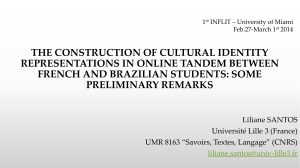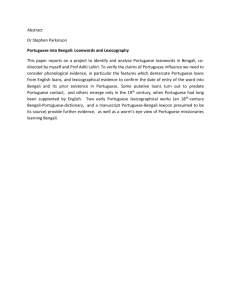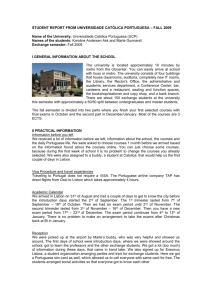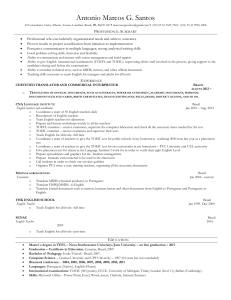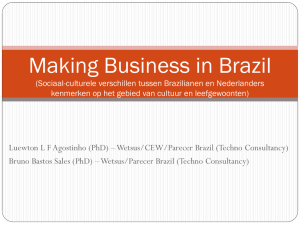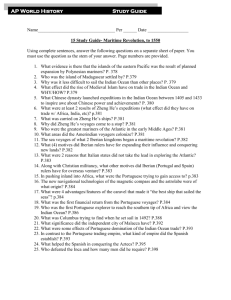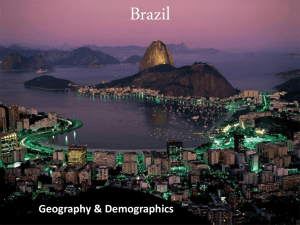PORTUGUESE-YEAR-ABROAD-ESSAY-TOPICS-2013-14
advertisement
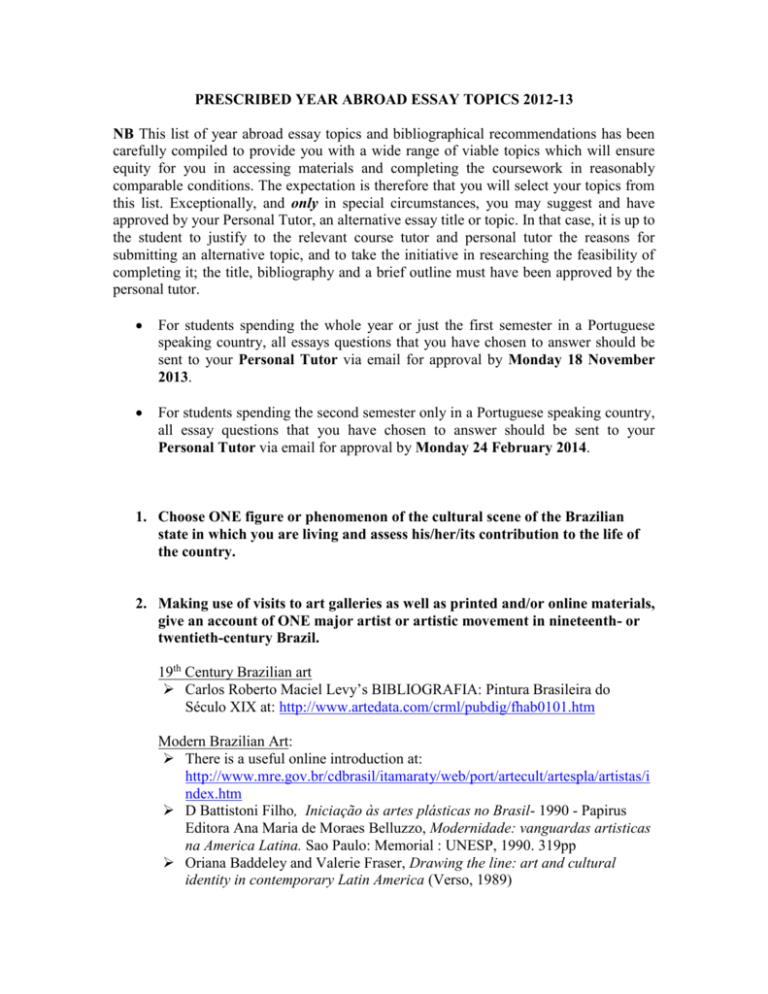
PRESCRIBED YEAR ABROAD ESSAY TOPICS 2012-13 NB This list of year abroad essay topics and bibliographical recommendations has been carefully compiled to provide you with a wide range of viable topics which will ensure equity for you in accessing materials and completing the coursework in reasonably comparable conditions. The expectation is therefore that you will select your topics from this list. Exceptionally, and only in special circumstances, you may suggest and have approved by your Personal Tutor, an alternative essay title or topic. In that case, it is up to the student to justify to the relevant course tutor and personal tutor the reasons for submitting an alternative topic, and to take the initiative in researching the feasibility of completing it; the title, bibliography and a brief outline must have been approved by the personal tutor. For students spending the whole year or just the first semester in a Portuguese speaking country, all essays questions that you have chosen to answer should be sent to your Personal Tutor via email for approval by Monday 18 November 2013. For students spending the second semester only in a Portuguese speaking country, all essay questions that you have chosen to answer should be sent to your Personal Tutor via email for approval by Monday 24 February 2014. 1. Choose ONE figure or phenomenon of the cultural scene of the Brazilian state in which you are living and assess his/her/its contribution to the life of the country. 2. Making use of visits to art galleries as well as printed and/or online materials, give an account of ONE major artist or artistic movement in nineteenth- or twentieth-century Brazil. 19th Century Brazilian art Carlos Roberto Maciel Levy’s BIBLIOGRAFIA: Pintura Brasileira do Século XIX at: http://www.artedata.com/crml/pubdig/fhab0101.htm Modern Brazilian Art: There is a useful online introduction at: http://www.mre.gov.br/cdbrasil/itamaraty/web/port/artecult/artespla/artistas/i ndex.htm D Battistoni Filho, Iniciação às artes plásticas no Brasil- 1990 - Papirus Editora Ana Maria de Moraes Belluzzo, Modernidade: vanguardas artisticas na America Latina. Sao Paulo: Memorial : UNESP, 1990. 319pp Oriana Baddeley and Valerie Fraser, Drawing the line: art and cultural identity in contemporary Latin America (Verso, 1989) AA Amaral, Artes plásticas ne Semana de 22: subsídios para uma história da renovação das artes no Brasil- 1972 - Editôra Perspectiva CT da Costa, Arte no Brasil 1950-2000: movimentos e meios- 2004 Alameda 3. Assess the contribution of ONE film-maker to an understanding of Brazilian society, with detailed reference to one or more films you have seen. Bernardet, Jean Claude, Cinema e Historia do Brasil / Jean-Claude Bernardet e Alcides Freire Ramos. [Sao Paulo]: Editora Contexto: Editora da Universidade de Sao Paulo, 1988. Randal Johnson and Robert Stam, editors, Brazilian Cinema, Expanded ed., Morningside ed. New York: Columbia University Press, c1995. Lisa Shaw and Stephanie Dennison, Brazilian National Cinema (Routledge, 2007) Lúcia Nagib, O cinema da retomada – depoimentos de 90 cineastas dos anos 90 (The Renaissance of Brazilian Cinema – Interviews with 90 Filmmakers of the 90s). São Paulo, Editora 34, 2002, 528 pp. Lúcia Nagib, The New Brazilian Cinema. London/New York, I.B. Tauris, 2003. Randal Johnson, Cinema Novo x 5: Masters of Contemporary Brazilian Film 1st ed. Austin, Tex.: University of Texas Press, 1984. Alex Viany, Introducao ao Cinema Brasileiro [Rio de Janeiro]: Alhambra : Embrafilme, 1987. Xavier, Ismail, Alegorias do Subdesenvolvimento: Cinema Novo, Tropicalismo, Cinema Marginal 1. ed. Sao Paulo, SP: Editora Brasiliense, 1993. 4. Assess the aims and activities of ONE NGO (non-governmental organisation) active in the city of Rio de Janeiro, São Paulo, Salvador or Belo Horizonte. See the following websites: http://ospiti.peacelink.it/zumbi/org/home.html http://www.guiademidia.com.br/ongs.htm http://www.brazilnetwork.org/ http://lab.org.uk/index.php Maria do Carmo Albuquerque Carvalho, “Participação social no Brasil hoje”, http://www.participacaopopular.org.br/FPPP/docs/participacao_social_no_br asil_hoje.doc Adilson Cabral, Rompendo Fronteiras: a Comunicação das Ongs editora: Achiamé, 1996 Paulo Cesar Pontes Fraga, “As ONGs e o espaço público no Brasil”, http://www.unesco.org.uy/most/seminario/ongsgobernancia/documentos/PauloPontesFraga.pdf 5. Critically compare the contributions of any TWO of the following writers to the image of the Brazilian sertão, making detailed reference to AT LEAST ONE volume of prose or poetry for each: Guimarães Rosa, Graciliano Ramos, Rachel de Queiróz, João Cabral de Melo Neto. Regionalismo, literatura e o sertão João Guimarães Rosa, Grande Sertão: Veredas Graciliano Ramos, Vidas Secas Rachel de Queiróz, O Quinze João Cabral de Melo Neto, Quaderna, A Educação pela pedra, Morte e Vida Severina Walnice Nogueira Galvão, “ Metamorfoses do sertão”, Revista Estudos Avançados., Dec. 2004, vol.18, no.52, p.375-394. ISSN 0103-4014. (download at: http://www.scielo.br/pdf/ea/v18n52/a24v1852.pdf) Ligia Chiappini, “DO BECO AO BELO: dez teses sobre o regionalismo na literatura”, http://www.cpdoc.fgv.br/revista/arq/170.pdf Janaína Amado, “Região, sertão, nação”, http://www.cpdoc.fgv.br/revista/arq/169.pdf Durval Muniz de Albuquerque Jr., A Invenção do Nordeste e outras artes (São Paulo: Cortez, 1999) Eduardo Portella et al., O Romance de 30 no nordeste (Fortaleza: PROED, 1983) 6. Compare the profile of candomblé and the igrejas evangélicas in the everyday, public life of Salvador. LEHMANN David, Struggle for the spirit : religious transformation and popular culture in brazil and latin america (Polity, 1996) BASTIDE, Roger. As Religiões Africanas no Brasil: Contribuições a uma Sociologia das Interpretações de Civilizações. São Paulo: Pioneira, 3 ed. 1989. BRAGA, Júlio Santana. Na Gamela do Feitiço: repressão e resistência no Candomblé da Bahia. Salvador: CEAO/EDUFBA, 1995. CARMO, João C. O que é candomblé. São Paulo: Brasiliense, 1987. 84p. Coleção Primeiros Passos, 200) HARDING, Rachel A Refuge in Thunder: Candomble and Alternative Spaces of Blackness (Indiana University Press, 2000) NASCIMENTO, Abdias do. Orixás: os deuses vivos da África. Rio de Janeiro: IPEADRO/Afrodiástica, 1995. 170p. ORTIZ, Renato 1988. Morte branca de um feiticeiro negro: umbanda e sociedade brasileira, São Paulo: Brasiliense. VERGER, Pierre. Orixás, deuses iorubás na África e no novo mundo. Salvador: Ed. Corrupio/Círculo do Livro, 1981. .Websites: http://www.mundonegro.com.br http://www.portalafro.com.br/ 7. Evaluate the cultural importance of popular festivals in Rio de Janeiro, São Paulo, Bahia or Minas Gerais William Rowe & Vivian Schelling, Memory and modernity: popular culture in Latin America (Verso, 1991) Alison Raphael, “From Popular Culture to Microenterprise: The History of Brazilian Samba Schools”, Latin American Music Review / Revista de Música Latinoamericana Vol. 11, No. 1 (Spring - Summer, 1990), pp. 73-83 Elizabeth Kiddy. Blacks of the Rosary in Memory and History in Minas Gerais Brazil (Penn State: 2005) Suzel Ana Reily, “To remember captivity: the ‘Congados’ of Southern Minas Gerais”, Latin American Music Review No.1 (2001), 4-30. (PDF copy available from DT) AZZI, Riolando 1976. O catolicismo popular no Brasil. Vozes:Petrópolis ARAUJO, Ubaritan Castro de (ed.) 1999. Salvador era Assim- memórias da Cidade CEAO: Salvador CARVALHO, Carlos Alberto de 1915.Tradiçoes e Milagres do Bonfim, Typographica Bahiana: Salvador. GUIMARÃES, Eduardo Alfredo Morais 1994 Religiao Popular, festa e o Sagrado, Dissertação de Mestrado UFBA QUERINO, Manuel 1955. A Bahia de Outrora, Libraría Progresso: Salvador LODY , Raul 1981 Devoçao e culto a Nossa Senhora de Boa Morte: pesquisa Sócio-religiosa. Altiva Gráfica e Editora :Rio de Janeiro. NASCIMENTO, Luiz Claudio Dias do 1999. Candomblé e Irmandade da Boa Morte Fundaçao Maria Cruz,Cachoeira, BA TAVARES, Odorico 1964. Bahia, Imagens da terra e do Povo Editora Civilização Brasileira, Rio de Janeiro VERGER, Pierre 1980. Orixás. Ed. Corrupio: Salvador. www.tambormineiro.com.br/congado.html www.cedepes.org.br (centro de documentação Eloy Ferreira da Silva) 8. Examine the role played by culture in a social movement of your choice, e.g. the Movimento dos Trabalhadores Sem Terra (MST); the Afro-Brazilian movement; favela movements; Fome Zero; Street Children projects. Sarah de Carvalho.The Street Children of Brazil: One Woman’s Remarkable Story (1996). Walter De Oliveira. Working with Children on the Streets of Brazil: Politics and Practice (2000) Tobias Hecht. At Home in the Street: Street Children of Norrtheast Brazil (1998) Cesar Augusto Rossatto `Social Transformation and “Popular Schooling” in Brazil. (street children and illiterate adults receive alternative schooling):” Childhood Education (Digital – Jul 28,2005) – Html. Michel Duquette. Collective Action and Radicalism in Brazil: Women,Urban Housing and Rural Movements (2005) Anthony Swift. Children for Social Change: Education for Citizenship of Street and Working Children in Brazil (The Educational Heretics Series) (1997) Emily Gustafsson-Wright `Gender dimensions fo child labor and street children in Brazil (2002). Jeanette Lukasse. A Cry from the Streets” Rescuing Brazil’s Forgotten Children (International Adventures) 2002. R. Mickelson. Children on the Streets of the Americas: Globalization, Homelessness and Education in the United States, Brazil, and Cuba (2000) Rachel E. Harding. A Refuge in Thunder: Candomblé and Alternative Spaces of Blackness (2003). Frances O’Gorman. Down to earth: 101 women from rural areas of Brazil tell their struggle to stay on the land (1987) James Petras and Henry Veltmeyer. Social Movements and State Power: Argentina, Brazil, Bolivia, Ecuador (2005). S Branford, J Rocha, Cutting the Wire: The Story of the Landless Movement in Brazil- 2002 - Latin America Bureau Sonia E. Alvarez, Evelina Dagnino, Arturo Escobar, Cultures of Politics/Politics of Cultures: Re-visioning Latin American Social Movements (Westview Press, 1998) 9. In the period since the military dictatorship, how has women’s participation in Brazilian society and politics changed? Sonia E. Alvarez. Engendering democracy in Brazil: Women’s Movements in Transition Politics (1990) Jone Edith Hahner. Women in Brazil (The Brazilian curriculum guide specialized bibliography) 1998. Frances O’Gorman. Down to earth: 101 women from rural areas of Brazil tell their struggle to stay on the land (1987) Carol Ann Drogusand Hannah W. Stewart-Gambino. Activist Faith: Grassroots Women in Democratic Brazil and Chile (2005) Daphne Patai. Brazilian Women Speak: Contemporary Life Stories (1988) Kia Lilly Caldwell. Negras in Brazil” Re-envisioning Black Women, Citizenship, and the Politics of Identity (2007) Michel Duquette,Maurilo Galdino, and Charmain Levy. Collective Action and Radicalism in Brazil: Women, Urban Housing and Rural Movements (Studies in Comparative Political Economy and Public Policy (2005). 10. Discuss the variety and complexity of the representation of women in the theatre of Gil Vicente (Auto da Índia, Auto da Sibila Cassandra, Pranto de Maria Parda, Auto da Barca do Inferno, Don Duardos). You should discuss aspects such as the construction of gender; the idealization of the female body; female codes of conduct; female enclosure (convent life, life in the palace); women as social margins (prostitution). Bernardes, José Cardoso, Sátira e Lirismo no Teatro de Gil Vicente (Lisbon: Imprensa Nacional – Casa da Moeda, 2006) Brilhante, Maria João, José Camões e Helena Reis Silva (eds.), Gil Vicente 500 anos depois (Lisbon: Imprensa Nacional – Casa da Moeda, 2003) David-Peyre, Yvonne, 1990. “Maria Parda, témoin de son temps”, Arquivos do Centro Cultural Português Garay, René, Gil Vicente and the Development of the Comedie (Chapel Hill: University of North Carolina, 1988) Hart, Thomas, Gil Vicente: Casandra and Don Duardos. Critical Guides to Spanish Texts 29 (London: Grant and Cutler with Tamesis, 1981) Osório, Jorge Alves, 'Solteiras e casadas em Gil Vicente', in Península, Revista de Estudos Ibéricos 2 (2005), 113-36. Stathatos, Constantine, 1998. A Gil Vicente Bibliography, 1975-1995: With a Supplement for 1940-1975. Lehigh University. Stathatos, Constantine, 1980. A Gil Vicente Bibliography 1940-1975. Grant & Cutler Ltd. 11. Explore the themes of homosexual desire and homoeroticism in the fiction of Sá-Carneiro in relation to modernist approaches to self-identity and aesthetic expression. De Marchis, Gregorio, 'Mário de Sá-Carneiro: Modernism Achieved by Means of Wrong Beauty' in Dix, Steffen and Jerónimo Pizarro (eds.), Portuguese Modernisms: Multiple Perspectives on Literature and the Visual Arts (London: Legenda, 2011), 42 – 54. Azevedo Filho, Leodegário A. de, “Mário de Sá-Carneiro e a teoria do duplo”. In Anais da Semana de Estudos Sá-Carneiro, ed. Lélia Parreira Duarte (RJ, 1994), 107 – 117. Butler, Judith, 1990. Gender Trouble. Feminism and the Subversion of Identity. London: Routledge. Duarte, Lélia Parreira. “A Confissão de Lúcio e a ironia romântica”. In Anais da Semana de Estudos Sá-Carneiro, ed. Lélia Parreira Duarte (RJ, 1994), 99 – 106. Pereira, Edgard. “A Confissão de Lúcio: o narrador no espelho”. Anais da Semana de Estudos Sá-Carneiro, ed. Lélia Parreira Duarte (RJ, 1994), 119 - 123. Martins, Fernando Cabral, O Modernismo em Mário de Sá-Carneiro (Lisbon: Editorial Estampa, 1994) Quadros, António (ed.), Mário de Sá-Carneiro: Cartas Escolhidas, 2 vols (Lisbon: Europa-América, 1990) Sá-Carneiro, Mário de, Princípio, A Confissão de Lúcio, Céu em Fogo (any editions). Sapega, Ellen, 1993. “Para uma aproximação feminista do modernismoPortuguês”, Discursos Femininos 5: 67-79. Segdwick, Eve Kosofsky (1985), Between Men. New York: Columbia Saraiva, Arnaldo (ed.), Cartas de Mário de Sá-Carneiro a Luiz de Montalvor/Cândida Ramos/Alfredo Guisado/José Pacheco (Lisbon: Limiar, 1977) Sasportes, José, História da Dança em Portugal (Lisbon: Fundação Calouste Gulbenkian, 1970) Sedgwick, Eve Kosofsky, 1985. Between Men: English Literature and Male Homossocial Desire. New York: Columbia University Press. ----, 1990. Epistemology of the closet. Berkeley: Los Angeles: University of California Press. Various, 'Mário de Sá-Carneiro a cem anos do seu nascimento', Colóquio/Letras, 117-118 (Set.-Dez. 1990) Wilde, Oscar, Salomé (any edition) Woll, Dieter. “Decifrando A Confissão de Lúcio”. In Estudos em Homenagem ao Prof. Vitorino Nemésio (1971), 425 – 437. 12. Discuss the following statement: “One of the internal senses connected with sight is the imagination or imaginatio, a concept we find in the Portuguese textual matter of Africa as informing both the writing of Africa and, in Camões’s case, the creation of a “memory” or collective, mental archive of history that is gradually chartered in Os Lusíadas.” (Josiah Blackmore, Moorings: Portuguese Expansion and the Writing of Africa: 93) Blackmore, Josiah. 2002. “Africa and the Epic Imagination of Camões”, Portuguese Literary and Cultural Studies 9 (2002): 107-115. Blackmore, Josiah, 2009. Moorings: Portuguese Expansion and the Writing of Africa. Minneapolis-London, Minnesota University Press. Boxer, Charles, 1969. The Portuguese Seaborne Empire. New York: Alfred Knopf. Clark, Stuart, 2007. Visions of the Eye : Vision in Early Modern European Culture. Oxford: Oxford University Press. Ferronha, António Luís (ed.), 1991. O confront do olhar: o encontro dos povos na época das navegações portuguesas, se´culos XV e XVI: Portugal, África, Ásia, América. Lisbon: Caminho… Fonseca, Luís Adão da, 1995. “Prologue: The Discovery of Atlantic Space”, in Winnius, George (ed.), Portugal: The Pathfinder: Journeys from the Medieval toward the Modern World ca. 1300-ca. 1600. Madison:Hispanic Seminary of Medieval Sudies Gil, Fernando & Helder Macedo, 1998. Viagens do Olhar: retrospecção, visão e profecia no renascimento português. Oporto: Campo das Letras. Monteiro, Nuno G., and António Costa Pinto. “Cultural Myths and Portuguese National Identity”, in Contemporary Portugal: Politics, Society and Culture, ed. António Costa Pinto (New York: Columbia University Press, 2011), 55 – 72. Nicolopoulos, James, 2000. The Poetics of Empire in the Indies: Prophecy and Imitation in La Araucana and Os Lusíadas. University Park: Pennsylvania State University. Silva, Vitor Aguiar e, 2011. Dicionário de Luís de Camões. Lisbon: Caminho. 13. In what way would you consider António Lobo Antunes’s As Naus and Manoel de Oliveira’s film Non, ou a Vã Glória de Mandar representative of a specific moment in Portuguese contemporary culture? Lobo Antunes, António, 1988. As Naus . Lisbon: Publicações Dom Quixote. Oliveira, Manoel de, 1990. Non, ou a Vã Glória de Mandar. Directed by Manoel de Oliveira [DVD]. Portugal-Spain-France: Madragoa Filmes. Arnaut, Ana Paula, and Carlos Alves dos Reis, António Lobo Antunes (Lisbon: Edições 70, 2009) Calafate Ribeiro, Margarida, and Ana Paula Ferreira, Fantasmas e Fantasias Imperiais no Imaginário Português Contemporâneo (Porto: Campo das Letras, 2003) Camões, Revista de Letras e Culturas Lusófonas 12/13 (2001): 'Manoel de Oliveira' Kaufmann, Helena, and Anna Klobucka (eds.), After the Revolution: Twenty Years of Portuguese Literature (Lewisburg: Bucknell University Press, 1997) Moutinho, Isabel, The Colonial Wars in Contemporary Portuguese Fiction (Woodbridge: Tamesis, 2008) Portuguese Literary and Cultural Studies 9 (2003): 'Post-Colonial Camões' Portuguese Literary and Cultural Studies 15/16 (2008): 'Facts and Fictions of António Lobo Antunes' Ramos, Jorge Leitão, 2006. História do Cinema Português. 1989-2003. Lisbon: Caminho. 14. Portugal’s Office of State Propaganda under Salazar organized commemorative events which promoted a homogeneous view of Portugal’s colonial and traditional past and present. Explore how this view was contradicted in other cultural forms of that time, EITHER in the work of Almada Negreiros (visual art and literary work) OR Irene Lisboa OR Lídia Jorge. Acciaiuoli, Margarida, 1998. Exposições do Estado Novo, 1934-1940. Lisbon: Horizonte. Alexandre, Valentim, 1995. “A África no imaginário português (séculos XIX XX)”. Penélope 5: 39-52. Almeida, José Carlos, 2005. Celebrar Portugal: A nação, as comemorações públicas e as políticas da nacionalidade. Lisbon: Instituto Piaget. Amado, Leopoldo, 1998. “A visão do negro na literature colonial”Angolê (october ‘ December): 6-7. Bethencourt, Francisco, 1999. “A memória da expansão”, in História da expansão portuguesa, v.5, Último império e recentramento (1930-1998), eds. F. Bethencourt / Kirti Chaudhuri, 442-83. Cabecinhas, Rosa, and Luís Cunha, 2003, “Colonialismo, identidade nacional e representações do negro”. Estudos do Século XX 3: 157-84. Kaufmann, Helena, and Anna Klobucka (eds.), After the Revolution: Twenty Years of Portuguese Literature (Lewisburg: Bucknell University Press, 1997) Medeiros, Paulo, and Maria José Ornelas, Da Possibilidade do Impossível: Leituras de Saramago (Utrecht: Portuguese Studies Center, 2007) Moutinho, Isabel, The Colonial Wars in Contemporary Portuguese Fiction (Woodbridge: Tamesis, 2008) Owen, Hilary, Portuguese Women's Writing 1972-1986: Reincarnations of a Revolution (Lewiston: Edwin Mellen, 2002) Portuguese Literary and Cultural Studies 2 (1999): 'Lídia Jorge: in Other Words' Sapega, Ellen, 2002. “Image and Counterimage; The Place of Salazarist Images of National Identity in Contemporary Portuguese Visual Culture, 1935-45LusoBrazilian Review 39 (2): 45 – 64. Sapega, Ellen, 2008. Consensus and Debate in Salazar’s Portugal: Visual and Literary Negotiations of the National Text, 1933 – 1948. Pennsylvania University Press. Amaral, Ana Luísa, 2001. Desconstruindo Identidades: Ler Novas Cartas Portuguesas à Luz da Teoria Queer. Corpo e Identidades: Cadernos de Literatura Comparada 3 (2001): 77-91. Besse, Maria Graciete , 2006. “As Novas Cartas Portuguesas e a Contestação do Poder Patriarcal” in Latitudes 26 (2006). Owen, Hilary, Claudia Pazos-Alonso (2001), Antigone's Daughters?: Gender, Genealogy and the Politics of Authorship in 20th-century Portuguese Women's Writing. Bucknell University Press. Pazos-Alonso, Claudia, 1996. Women, Literature and Culture in the Portuguesespeaking World . Edwin Mellen Press. Sadlier, Darlene, The Question of How: Women Writers and New Portuguese Literature .New York: Greenwood Press. 15. Explore the concepts of nationalism, collective memory, myth, utopia in Fernando Pessoa’s Mensagem. Almeida, Onésimo Teotónio de, Mensagem. Uma Tentativa de Interpretação (Angra do Heroismo, Azores: Direcçao Regional dos Assuntos Culturais, 1987) Blanco, José, ‘Fernando Pessoa, Europe and the Portuguese Discoveries’, trans. Janet Louth, in Eugénio Lisboa with L.C. Taylor (eds), A Centenary Pessoa (Manchester: Carcanet Press, 1995) Feijó, António M., ‘Mensagem, a imprecisão denotativa de “um drama em gente” e o anticristianismo de Pessoa’, Românica, No. 8 (1999), 65-77 - - - -, ‘Fernando Pessoa’s Odd Epic’, in A Revisionary History of Portuguese Literature, eds Miguel Tamen and Helena C. Buescu (New York-London: Garland Publishing, 1999) Macedo, Helder, 'A Mensagem e as mensagens de Oliveira Martins e de Junqueiro', Colóquio/Letras 103 (Maio-Junho 1988), 28-39 Sousa, Ronald W., ‘The Structure of Pessoa’s Mensagem’, Bulletin of Hispanic Studies, 59 (1982), 58-66 16. ‘In José Régio’s short story, ‘O Vestido Cor de Fogo’ (in Histórias de Mulheres), the husband is the result of, and the victim of, Western society’s conflicting attitudes to love and marriage.’ Discuss. Galhoz, Maria Aliete, Catorze Ensaios sobre José Régio: seguidos de uma biobibliografia essencial (Lisbon: Cosmos, 1996) Lisboa, Eugénio, José Régio - A Obra e o Homem, Lisbon: Arcádia, 1976 Perkins, Juliet, ‘Marry in Haste: José Régio’s “O Vestido Cor de Fogo”’, in T.F. Earle & Nigel Griffin (eds), Portuguese, Brazilian and African Studies, presented to Clive Willis on his Retirement (Warminster: Aris & Phillips, 1995), pp. 229-38 Rougement, Denis de, L’Amour et l’occident (Paris: Plon, 1939); translated as Passion and Society, by Montgomery Belgion, revised and augmented edn (London: Faber / Faber, 1956); [also translated into Portuguese] - - - -, Love in the Western World, trans. Montgomery Belgion (Princeton: Princeton University Press, 1983) 17. Write an analysis of any one of the following poem cycles from Herberto Helder’s A Colher na Boca: ‘O Poema’, ‘Fonte’, ‘Elegia Múltipla’, ‘As Musas Cegas’. If relevant, draw attention to amendments made by the poet to each new edition or anthology of his works. Dal Farra, Maria Lúcia, A Alquimia da Linguagem (Lisbon: Imprensa NacionalCasa da Moeda, 1985) Guedes, Maria Estela, Herberto Helder – Poeta Obscuro (Lisbon: Moraes, 1978) Ladeira, António, ‘The Poet is Not a Faker: Herberto Helder and the Myth of Poetry’, at http://www.plcs.umassd.edu/plcs7texts/ladeira.doc Marinho, Maria de Fátima, Herberto Helder: a Obra e o Homem (Lisbon: Arcádia, 1982) Martins, Manuel Frias, Um Silêncio de Bronze (Lisbon: Livros Horizonte, 1983) Perkins, Juliet, The Feminine in the Poetry of Herberto Helder (London: Tamesis Books, 1991) Rosa, António Ramos, ‘Herberto Helder, Poeta Órfico’, in Poesia, Liberdade Livre (Lisbon: Moraes, 1962) Textos e Pretextos, No. 1 (Inverno, 2002), issue devoted to Herberto Helder 18. Discuss Fernando Assis Pachecho’s treatment of the experience and memory of the colonial war, in Catalabanza, Quilolo e Volta (1976). Pacheco, Fernando Assis, A Musa Irregular (Lisbon: Assírio e Alvim, 1991) Ribeiro, Margarida Calafate, ‘No plaino abandonado um poeta cercado – a memória da guerra colonial na poesia de Fernando Assis Pacheco’ at http://www.geocities.com-ail_br/oplainoabandonado.htm 19. What created Canudos in the Brazilian North-East in the 1890s? What destroyed it? This question is intended to enable you to explore social, economic, political, and cultural conditions between periphery and centre in late nineteenth-century Brazil. Introduction to the literature Da Cunha, Euclides, Os Sertões (1902); published in English as Rebellion in the Backlands (1944); many later editions of both. The key journalistic account of the Canudos war, and a milestone in Brazilian letters. Levine, Robert, Vale of Tears: Revisiting the Canudos Massacre in Northeastern Brazil, 1893-1897 (Los Angeles & London: 1991). Leading academic study of Canudos. Levine, Robert (ed.), Luso-Brazilian Review 30:2 (Winter 1993), special issue, “The World out of Which Canudos Came”. Collection of dedicated articles. Vargas Llosa, Mario, The War of the End of the World (1981; London: 2004). Brilliant (if misleading?) imaginative recreation of the Canudos episode. 20. What did Getúlio Vargas perceive to be the major challenges facing midtwentieth century Brazil? How successful was the Estado Novo in dealing with those challenges? This question enables you to explore the political persona and aims of Brazil’s most important statesman of the twentieth century. It is also designed to explore the notion of the Estado Nôvo as a key turning point (or not) in modern Brazilian history. Introduction to the literature Dulles, John, Vargas of Brazil: A Political Biography (Austin, Texas: 1967). The standard biography. Hentschke, Jens (ed.), Vargas and Brazil: New Perspectives (New York & Basingstoke: 2006). Excellent recent collection of essays. Levine, Robert, Father of the Poor? Vargas and his Era (Cambridge: 1998). Recent-ish academic study by a leading authority. Wolfe, Joel (ed.), Luso-Brazilian Review 31:2 (Winter 1994), special issue, “Getúlio Vargas and his Legacy”. Dedicated collection of articles. 21. How democratic has Brazil become since the end of military rule in 1984? You are free to interpret this question in strictly political terms, or you may extend your enquiry to economic and social policy since the return to democracy. Introduction to the literature D’Alva Kinzo, Maria, & James Dunkerley (eds.), Brazil since 1985: Economy, Polity and Society (London: 2003). Excellent and wide-ranging collection of essays. Kingstone, Peter, & Timothy Power (eds.), Democratic Brazil (Pittsburgh: 2000). Collection of essays which takes the themes discussed in Stepan (ed.) through to Cardoso’s first term. Stepan, Alfred (ed.), Democratizing Brazil (New York: 1989). Major collection focusing on the transition and early years of civilian rule. Vidal Luna, Francisco, & Herbert Klein, Brazil since 1980 (Cambridge: 2006). More economic in focus than D’Alva Kinzo & Dunkerley, but includes several chapters on politics and society. 22. How have patterns of Portuguese emigration changed since the third quarter of the nineteenth century? Describe the main areas of origin and destination, changes in flows and main forces at work, with particular attention to socio-economic and political contexts. If you wish you may select one period for more detailed discussion of policy responses and public debates. If you prefer you may focus your answer on the experience and impact of migration either on those left behind or the migrants themselves drawing on literary representations, diaries, film or visual arts sources. 23. How has immigration impacted upon Portuguese society? Describe the origins, chronology and character of different migratory flows. What is the appropriate chronological span for the discussion of this question? Were population movements during the colonial period relevant? How relevant are the legacies of empire? How has diversification impacted upon everyday life, senses of community and the economy? What are the public attitudes to immigration and how have public debates constructed the discussion of the opportunities and problems of immigration? How has the immigration debate translated into legislation and nationality law in particular? Has the immigration question had any effect on the political scene? Notes: a) A CD with many of the works of art relating to the representation of the experience of Portuguese migration was produced to accompany the ‘Traços da Diáspora Portuguesa’ exhibition at Gare Marítima de Alcantâra sponsored by the Museu da Presidencia (13 Nov. 2007-30 Jan. 2008). b) the bibliographies on Portuguese emigration and immigration to Portugal are huge, the following offer excellent up to date overviews and further references which you should follow up along the lines of the specific threads focused upon in your essay: Geografia de Portugal, Direcção de Carlos Alberto Medeiros, vol.2: Sociedade, Paisagens e Cidades, and vol.3: Actividades Económicas e Espaço Geográfico, Lisboa: Círculo de Leitores, 2005; António Reis, coord., Retrato de Portugal: Factos e Acontecimentos, Lisboa: Temas & Debates, 2007 c) For all issues relating to Immigration consult the archives, publications and bibliographies in the sites of Observatório da Imigração and ACIDI (see resources below). *** 24. Describe and discuss the patterns of voting in Portuguese presidential, legislative, local or European elections in the any of the three decades since the revolution. Describe the changing patterns of electoral participation in the period of your choice. Explain the significance attached to each of the three levels of political participation in the debates about citizenship, political expression and apathy. Pay particular attention to the debates surrounding these questions in terms of the quality of Portuguese democracy, political culture, democratisation, citizenship and European integration. For resources and detailed bibliographical suggestions see below.*** 25. Discuss critically and in detail the representation of Portuguese history and society in one Portuguese film of either the New State or of the post-74 period. Never discuss a film simply on the basis of secondary literature, ensure that your essay draws on your viewing of the film. Though you may want to focus on the visual and ideological aspects of particular scenes, always set such discussions in the context of the economy of the film as a whole, and the cultural and political contexts at the time of production. Wherever possible consider also issues of reception and the status of the particular film in Portuguese culture and film history. For documentaries you will find the magazine Doc.pt most useful. The Cinemateca Portuguesa is an invaluable resource. A good starting point in the bibliography are the following: Portugal: Um Retrato Cinematográfico/ Portugal: A Cinematographic Portrait, Lisboa: Número-Arte&Cultura, 2004 Cinema Português através dos Seus Filmes, Carolin Overhoff Ferreira, coord., Porto: Campo das Letras, 2007 João Mário Grilo, O Cinema da Não-Ilusão: histórias para o cinema português, Lisboa: Livros Horizonte, 2006 26. Drawing on the personal narratives recorded in Margarida Calafate Ribeiro’s África no Feminino discuss the impact of the colonial wars on this generation of Portuguese women and its reverberations in contemporary collective memory. Though drawing on the rich and excellent introductory essay answers should draw directly and in detail on your reading of the first person narratives collected in the book. You may also wish to set discussion of the contributions in the book within the wider contexts of the historiographical contributions from women’s studies and women’s history to the reevaluation of contemporary Portuguese history. Margarida Calafate Ribeiro, África no Feminino: As Mulheres Portuguesas e a Guerra Colonial, Porto: Afrontamento, 2007. a) In a addition to a number of recent books and contributions (such as those by Irene Vaquinhas and Anne Covas, and the women’s history series published by Livros Horizonte among others) see in particular the journals ex aequo (especially issues 5 & 6 on A Construção dos Estudos Sobre as Mulheres em Portugal) and Faces de Eva. b) For a starting point on the recent contributions to the historiography of the colonial wars see Manuel Themudo Barata and Nuno Severiano Teixeira (gen. eds.), Nova História Militar de Portugal, Lisbon: Círculo de Leitores, vol., 5 27. How justified was the Portuguese theory of Lusotropicalismo in relation to its African colonies? Gilberto Freyre, Integração portuguesa nos trópicos (Lisbon, Ministério do Ultramar, 1958). Gilberto Freyre, O mundo que o Português criou (Rio de Janeiro, José Olympio, 1940). Gilberto Freyre, The Masters and the Slaves, (any edition). Gerald Bender,Angola under the Portuguese (London; Heinemann, 1978) Charles R. Boxer, Race Relations in the Portuguese Colonial Empire (Oxford: Clarendon Press, 1963). Malyn Newitt, Portugal in Africa (London: Hurst, l981) 28. How far did gender roles in Lusophone Africa change following the wars of independence? This question allows you to explore the history of the independence in Lusophone Africa and its long-term effects through the prism of gender relations, an increasingly important topic in Africanist studies. The book by Havik contextualizes these over the longue durée; the two edited books offer a synthesis of both gender studies and postcolonial studies from across Lusophone Africa, and the other reading suggestions then offer more specific examples from a range of Lusophone countries. Patrick Chabal, Amilcar Cabral: Revolutionary leadership and People’s War London: Christopher Hurst, 2003. Patrick Chabal (ed.), A History of Postcolonial Lusophone Africa. Bloomington: Indiana University Press, 2002. Philip J Havik, Silences and Soundbytes: The Gendered Dynamics of Trade and Brokerage in the Pre-Colonial Guinea-Bissau Region, Munster: Lit Verlag, 2004. José Vicente Lopes, Cabo Verde: Os Bastidores da Independencia. Praia; Spleen Edições, 2007. Rosa Melo, Homem é Homem, Mulher é Sapo: Género e Identidade entre os Handa no Sul de Angola. Lisbon: Colibri, 2007. Meredith Turshen and Clothilde Twagiramariya (eds)., What Women do in Wartime: Gender and Conflict in Africa London: Zed Books, 1998. Stephanie Urdang, Fighting Two Colonialisms: Women in Guinea-Bissau, Monthly Review Press, 1980. Stephanie Urdang, And Still They Dance: Women, War and the Struggle for Change in Mozambique, Monthly Review Press, 1989. 29. How “Portuguese” were the Luso-Africans? This question invites you to consider the long-term roots and influences of Portuguese colonialism in Lusophone Africa; it may stand as a good preparation for a possible Level 6 module on cross-cultural connections between Africa and the Americas which will be offered next year. In the Guinea-Bissau region, Angola and Mozambique, there were gobetween traders known as the Luso-Africans who acted as intermediaries between Portuguese and Brazilian traders and African polities. They adopted Portuguese language and dress, but were often incoprorated within African societies through African lineage patterns. You are welcome to cosnsider any one of these regions in detail, or to work comparatively. George E. Brooks, Eurafricans in Western Africa: Commerce, Social Status, Gender, and Religious Observance. Columbus: Ohio University Press, 2003. Toby Green (ed.), Brokers of Change: Atlantic Commerce and Cultures in PreColonial Western Africa. Oxford: Oxford University Press, 2012 (esp. Chs 1, 3, 11). Allen F Isaacman: Mozambique: Africanization of a European Institution, the Zambezi Prazos, 1750-1902. Madison: University of Wisconsin Press, 1972. Peter Mark, “Portuguese” Style and Luso-African Identity: Precolonial Senegambia, Sixteeenth-Nineteenth Centuries. Bloomington: Indiana University Press, 2002. Joseph C. Miller, Way of Death: Merchant Capitalism and the Angolan Slave Trade, 1730-1830. Madison: University of Wisconsin Press, 1996. (esp chapter on Luso-Africans). Malyn Newitt, A History of Mozambique London: C Hurst (esp chapter on the prazos)

